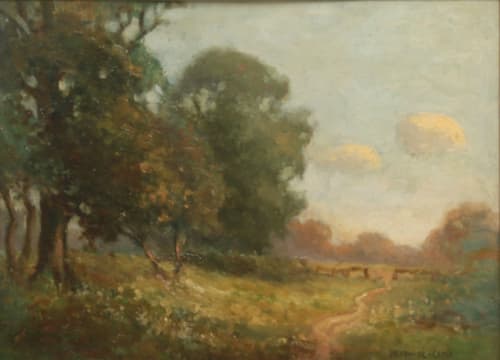Born in Cincinnati, Ohio on November 5, 1858, Joseph DeCamp began his artistic career in his teens and remained active throughout his life. Although he initially painted landscapes, Decamp became a renowned and respected portraitist. He was famous for his images of men of high society and women within domestic interiors.
Decamp began his artistic training in 1873 when he enrolled in the McMicken School of Art and Design in Cincinnati. The head of the school, Thomas Satterwhite Noble, was a European-trained painter whose "insistence on rigorous draftsmanship, true to the academic manner in which he had been trained, exerted a lasting influence on DeCamp." DeCamp studied under Noble for five years, but was also a student of Frank Duveneck at the Ohio Mechanics Institute. He adopted Duveneck's bold, realistic style and many of his paintings executed throughout the 1870s and 1880s reflect this influence.
Like most American artists of his generation, DeCamp went abroad to study. In 1878, following in the footsteps of Duveneck and other Midwesterners, he traveled to Munich to attend the Royal Bavarian Academy. Soon after his arrival, however, he gravitated away from the academy and towards Duveneck and eventually followed his mentor to Florence and Venice. During these years, DeCamp focused on landscape and portraiture as his primary subjects. These themes would continue to occupy the artist when he returned to America in 1883.
When DeCamp arrived back in the United States in 1883, he first settled in Cincinnati, but soon moved to Cleveland to teach at what is now Case Western Reserve University. He then relocated once more to the Boston area, where he would remain for most of his life. DeCamp began teaching at Wellesley Female Academy and, in the fall of 1885, began as an instructor at the School of Drawing and Painting at the Museum of Fine Arts in Boston. He quickly established himself as one of the leading figures in the Boston art community and became a founding member of The Ten American Painters, formulated in 1897. This group included Childe Hassam, John Henry Twachtman, Julian Alden Weir, Frank Benson, Thomas Dewing, Willard Metcalf, Robert Reid, Edward Simmons, Edmund Tarbell, and William Merritt Chase. These artists were dedicated to experimentation with various styles, particularly impressionism. They also wanted more opportunity for exhibitions outside the established venues. Many, including DeCamp, had joined the Society of American Artists (SAA) when this group broke from the conservative National Academy of Design in 1877. However, The Ten American Painters felt that the SAA had itself become too restrictive. Banding together, The Ten exhibited their works as a group between 1898 and 1919. Unfortunately, many of his works were destroyed in fires at both his Boston and Maine studios.
Like most painters of his time, DeCamp usually left the bustle of the urban environment during the summer months and sketched and painted outdoors. According to DeCamp biographer Laurene Buckley, the artist "returned to landscape as a subject, especially in 1886, after he had spent the first of many summers at Annisquam on the Massachusetts coast, near Gloucester." Painters such as Hugh Bolton Jones, William Lamb Picknell, and others who had worked at the Pont-Aven art colony in Brittany frequented the thriving art community that developed in Annisquam. Many of these artists, including DeCamp, worked en plein air. This technique of sketching outdoors was wholeheartedly endorsed by William Morris Hunt, the leading Boston landscapist of the day.
While DeCamp painted and exhibited landscapes, he is best known for his portraits and for his scenes of women at leisure. His paintings of women in the first decade of twentieth century exhibit the influence of Jan Vermeer. His last work The Blue Mandarin Coat (The Blue Kimono), 1922 displayed the vogue for Japanese textiles and porcelain (japonisme) at the turn of the century in Boston. When DeCamp died on February 11, 1923 a memorial wreath was placed beneath the work, which was then in the annual show at the Pennsylvania Academy of Fine Arts.

